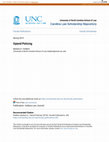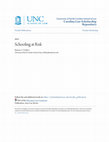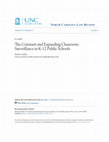Papers by Barbara Fedders

The Journal of Law of Education, Oct 1, 2013
The school-to-prison pipeline is a collection of punitive laws, policies, and practices that push... more The school-to-prison pipeline is a collection of punitive laws, policies, and practices that push young people -- particularly African-American students, male students, students with disabilities, and students from low-wealth communities -- out of school and into the juvenile and criminal systems. By understanding and asserting their clients' educational rights and incorporating their clients' education histories and records into their delinquency representation, juvenile defenders can help dismantle the pipeline.The school-to-prison pipeline is a collection of punitive laws, policies, and practices that push young people, particularly African-American students, male students, students with disabilities, and students from low-wealth communities out of school and into the juvenile and criminal systems. By understanding and asserting their clients' educational rights and incorporating their clients' education histories and records into their delinquency representation, juvenile defenders can help dismantle the pipeline. Specifically, incorporation of their clients' education histories and knowledge of education law can assist a defender in making arguments for diversion from the juvenile system; improving negotiation; litigating pretrial motions; arguing defenses related to capacity and intent; making creative dispositional arguments; and obtaining essential educational services for the client, all of which can reduce the client's chances of further juvenile and criminal system involvement. We provide a brief history of the increased imposition of excessively punitive discipline and law enforcement imperatives on public education. This history includes reference to data showing that excessive discipline and heightened law enforcement presence fail to make schools safer. We discuss the consequences of harsh disciplinary policies, including increased referrals to juvenile and criminal systems and exclusion of ever growing numbers of students from the education system. Part III sets forth the ethical backdrop for the argument that defenders have a role to play in helping dismantle the pipeline. Part IV makes specific practice recommendations for defenders in their delinquency representation as well as advocacy suggestions for advancing educational rights.

The primary mission of North Carolina schools is to provide students an excellent education. To f... more The primary mission of North Carolina schools is to provide students an excellent education. To fully achieve this mission, schools must not only be safe, but also developmentally appropriate, fair, and just.Unfortunately, many so-called "school safety" proposals in the wake of the tragedy in Newtown, Connecticut have been shortsighted measures inspired by political expediency but unsupported by data. We aim to provide a more thoughtful approach informed by decades of research and centered on the mission of public schools.This issue brief responds to the newly established N.C. Center for Safer Schools, which has requested public input on "local concerns and challenges related to school safety" and has made available the opportunity to submit written comments.The first section of the brief debunks common myths and provides essential facts that must provide the backdrop for the school safety debate. The second section offers proven methods of striving for safe, dev...

This Article identifies and explores a new, local law enforcement approach to alleged drug offend... more This Article identifies and explores a new, local law enforcement approach to alleged drug offenders. Initially limited to a few police departments, but now expanding rapidly across the country, this innovation takes one of two primary forms. The first is a diversion program through which officers refer alleged offenders to community-based social services rather than initiate criminal proceedings. The second form offers legal amnesty as well as priority access to drug detoxification programs to users who voluntarily relinquish illicit drugs. Because the upsurge in addiction to — and death from — opioids has spurred this innovation, I refer to it as “opioid policing.” This new approach improves in key ways upon previous state responses to illicit drug use. Opioid policing has explicit public-health aims — seeking improved life outcomes for people addicted to drugs without relying on arrest. By contrast, the War on Drugs incentivized arrests, which create myriad negative consequences ...

Social Science Research Network, Mar 14, 2021
Police officers have become permanent fixtures in public schools. The sharp increase in the numbe... more Police officers have become permanent fixtures in public schools. The sharp increase in the number of school police officers over the last twenty years has generated a substantial body of critical legal scholarship. Critics question whether police make students safer. They argue that any safety benefits must be weighed against the significant role the police play in perpetuating a school-to-prison pipeline that funnels Black and Brown students and students with disabilities out of schools and into courts, jails, and prisons. In suggesting remedies for this problem, commentators have proposed several regulatory fixes. These include changes to the standards for evaluating students' claims of constitutional rights violations, specialized police trainings, and voluntary agreements between law enforcement agencies and school districts that circumscribe the role of school police. Thus far, however, legal scholars have focused primarily on the "how" of school policing, eschewing the logically prior normative question of whether there should be police in schools at all.

Police officers have become permanent fixtures in public schools. The sharp increase in the numbe... more Police officers have become permanent fixtures in public schools. The sharp increase in the number of school police officers over the last twenty years has generated a substantial body of critical legal scholarship. Critics question whether police make students safer. They argue that any safety benefits must be weighed against the significant role the police play in perpetuating a school-to-prison pipeline that funnels Black and Brown students and students with disabilities out of schools and into courts, jails, and prisons. In suggesting remedies for this problem, commentators have proposed several regulatory fixes. These include changes to the standards for evaluating students' claims of constitutional rights violations, specialized police trainings, and voluntary agreements between law enforcement agencies and school districts that circumscribe the role of school police. Thus far, however, legal scholars have focused primarily on the "how" of school policing, eschewing the logically prior normative question of whether there should be police in schools at all.

Iowa Law Review, 2018
For much of the nation’s history, states excluded entire groups of students from mainstream publi... more For much of the nation’s history, states excluded entire groups of students from mainstream public-school classrooms based on classifications of race or disability. Although Brown vs. Board of Education and its progeny, as well as the Individuals with Disabilities Education Act, now prohibit the most blatant and egregious forms of this type of exclusion, a new version has emerged. Over the last thirty years, schools have suspended, and transferred into separate schools known as Alternative Education Programs (“AEPs”), a significant and growing number of students. Proponents of this new version of exclusion argue that these practices can help to curb misbehavior, promote school safety, and assist students in obtaining academic success. Yet research shows that suspending students does little to improve behavior; nor does it necessarily improve school safety. And while policymakers intend for AEPs to re-engage students at risk of educational failure, they are often demonstrably inferio...

North Carolina Law Review, 2019
New technologies are expanding schools’ ability to keep students under surveillance—inside the cl... more New technologies are expanding schools’ ability to keep students under surveillance—inside the classroom and out, during the school year and after it ends. Schools have moved quickly to adopt a dizzying array of new tools. These include digital learning products that capture and store student data; anonymous tip lines encouraging students to report on each other; and software that monitors students’ emails and social media posts, even when they are written from home. Steadily growing numbers of police officers stationed in schools can access this information, compounding the technologies’ power. Advocates of these tools argue that they improve student safety and learning outcomes, but this Article reveals that the evidence for this argument is in fact quite thin. Moreover, policymakers have failed to consider important countervailing considerations—most notably, student privacy and its significance for child development; unequal impact, particularly for poor, Black, and LGBTQ youth;...

Convened by juvenile court judges, an "anti-pipeline collaborative" brings together rep... more Convened by juvenile court judges, an "anti-pipeline collaborative" brings together representatives from law enforcement, education, and mental health agencies to devise protocols for reducing both court referrals and suspensions for in-school misbehavior. Anti-pipeline collaboratives are new and have the support of both foundations and a national organization of juvenile and family court judges. Structurally, the collaboratives resemble both the community-based, multi-stakeholder entities favored by scholars of "new governance," as well as the "problem-solving courts" devised by judges seeking alternatives to traditional criminal adjudication. Along with a descriptive account of the anti-pipeline collaborative, this Essay offers the beginnings of a normative assessment. While collaboratives have the potential to ameliorate some of the harms of criminalized discipline, I query whether their structure and composition might not instead problematically nor...
Children, Sexuality, and the Law, 2015
SSRN Electronic Journal, 2013
Iowa Law Review, Mar 1, 2018
provided excellent research assistance. Finally, thanks to the staff of the Iowa Law Review and, ... more provided excellent research assistance. Finally, thanks to the staff of the Iowa Law Review and, in particular, to Emily Asp, for a particularly helpful set of questions and suggestions.

The school-to-prison pipeline is a collection of punitive laws, policies, and practices that push... more The school-to-prison pipeline is a collection of punitive laws, policies, and practices that push young people -- particularly African-American students, male students, students with disabilities, and students from low-wealth communities -- out of school and into the juvenile and criminal systems. By understanding and asserting their clients' educational rights and incorporating their clients' education histories and records into their delinquency representation, juvenile defenders can help dismantle the pipeline.The school-to-prison pipeline is a collection of punitive laws, policies, and practices that push young people, particularly African-American students, male students, students with disabilities, and students from low-wealth communities out of school and into the juvenile and criminal systems. By understanding and asserting their clients' educational rights and incorporating their clients' education histories and records into their delinquency representation, juvenile defenders can help dismantle the pipeline. Specifically, incorporation of their clients' education histories and knowledge of education law can assist a defender in making arguments for diversion from the juvenile system; improving negotiation; litigating pretrial motions; arguing defenses related to capacity and intent; making creative dispositional arguments; and obtaining essential educational services for the client, all of which can reduce the client's chances of further juvenile and criminal system involvement. We provide a brief history of the increased imposition of excessively punitive discipline and law enforcement imperatives on public education. This history includes reference to data showing that excessive discipline and heightened law enforcement presence fail to make schools safer. We discuss the consequences of harsh disciplinary policies, including increased referrals to juvenile and criminal systems and exclusion of ever growing numbers of students from the education system. Part III sets forth the ethical backdrop for the argument that defenders have a role to play in helping dismantle the pipeline. Part IV makes specific practice recommendations for defenders in their delinquency representation as well as advocacy suggestions for advancing educational rights.
Page 1. Do Not Delete 4/7/2010 5:44 PM 771 LOSING HOLD OF THE GUIDING HAND: INEFFECTIVE ASSISTANC... more Page 1. Do Not Delete 4/7/2010 5:44 PM 771 LOSING HOLD OF THE GUIDING HAND: INEFFECTIVE ASSISTANCE OF COUNSEL IN JUVENILE DELINQUENCY REPRESENTATION by Barbara Fedders * Lawyers for children ...
Journal of Psychiatry Law, Oct 1, 2011
University of Maryland Law Journal of Race Religion Gender and Class, Dec 1, 2013
prison-pipeline (last visited Sept. 13, 2013) ("The 'school-to-prison pipeline' refers to the pol... more prison-pipeline (last visited Sept. 13, 2013) ("The 'school-to-prison pipeline' refers to the policies and practices that push our nation's schoolchildren, especially our most at-risk children, out of classrooms and into the juvenile and criminal justice systems.").
The primary determinant for entrenched involvement in the juvenile justice system is the socioeco... more The primary determinant for entrenched involvement in the juvenile justice system is the socioeconomic status of a child's family. This article explores avenues of legal advocacy within that system.
Nevada Law Journal, 2006
Barbara Fedders* I. INTRODUCTION While they may have kept them secret, adolescents have always ha... more Barbara Fedders* I. INTRODUCTION While they may have kept them secret, adolescents have always had samesex romantic and sexual relationships. They have always transgressed gender norms. And beginning thirty years ago,' increasing numbers of young people have "come out" '2-at ever younger ages 3-as lesbian, gay, bisexual, transgender, or queer. Still others question their sexual orientation and gender identity. Yet even the most thoughtful and conscientious child advocates traditionally have not acknowledged these young people or addressed the unique stressors they face. 4 Building on the pioneering advocacy of attorneys from Legal Services for Children, the National Center for Lesbian Rights, and the Lambda Legal Defense Fund, I seek in this article to respond to that omission. 5 I argue here
In step with the significant civil rights advances for LGBT adults over the last ten years, advoc... more In step with the significant civil rights advances for LGBT adults over the last ten years, advocates for LGBT youth in the child welfare and juvenile justice systems have won major law and policy changes. This article sets forth the typical reasons that youth enter the child welfare and juvenile justice systems, analyzes the significance of the recently won legal and policy shifts, and offers thoughts for a more liberatory approach toward gender and sexuality that can reduce the numbers of youth in the system.











Uploads
Papers by Barbara Fedders